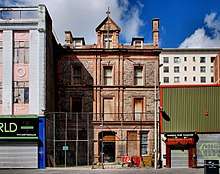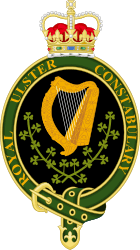Queen Street Childrens Hospital
Coordinates: 54°35′54.40″N 5°56′00.00″W / 54.5984444°N 5.9333333°W This article concerns the building in Belfast Northern Ireland generally referred to as the Queen Street Childrens Hospital, the Belfast Hospital for Sick Children, and the Queen Street RUC Station. It was home to a childrens hospital from 1878 to 1932, and was a Royal Ulster Constabulary barracks from 1933 to 2000. It has been effectively abandoned since then and is visibly deteriorating.[1]
Foundation
The initial meeting was held at 25 King Street, Belfast, on 15 May 1873. The event was presided over by James Henderson, who would eventually become Lord Mayor of the city. It was attended by 15 other gentlemen representing major industries at the time.
A Board of Management was set up to establish funding and run the resulting medical practice. The main focus was to provide healthcare to the impoverished in a time where government assistance was unknown. The building and general running costs had to come from the public. In deference to this, the original writing which spanned all three storeys on the front of the finished hospital would read; Erected A.D.1878 By Voluntary – Subscriptions And Donations – Belfast Hospital For Sick Children.[3]

Some of the more prominent founding Board members were;
- Baron William O'Neill – President. There was a marble tablet installed above the main door to the surgical ward dedicated to his efforts. The presidency passed to his son Robert after his death in 1883.
- William Robertson – Chairman
- Herbert Darbishire – Honorary Secretary
- Robert S Craig – Honorary Treasurer
- Sir Thomas Dixon – Patron
- Lady Edith Dixon – Patron
Darbishire once said of that first meeting;
"...a few gentlemen of intelligence and earnestness met in a small dusty room in King Street. The speeches were short, but there was the right ring in what was said; it meant work; it meant success."
Little is known about the fundraising process other than it began with a citywide distribution of flyers. By 1876 they had managed to raise £2000 and the Board decided that this was sufficient for work to begin.[4]
Building
The site was purchased from the Belfast Corporation in 1876 as an empty plot of land beside the recently built Gas Office. Prior to this, the plot had been used by the Mechanics Guild.[3][5]
The building contractor was William McCammond who would also later go on to become the Lord Mayor of Belfast.[3]
Thomas Jackson & Son of Corn Market were commissioned to design the hospital. Thomas and his two sons are credited with designing many of the iconic buildings in and around Belfast.[6][7] Anthony had left the company by this date so the design was probably a collaborative effort between William and his father. Notable examples of their work would include;
.jpg)
- The Limerick, Belfast, and Lisburn Quaker Meeting Houses
- The Belfast Ulster Bank Branches
- The Belfast Natural History Museum
- May Street Music Hall, Belfast
- St. Malachy's Church, Belfast
- The Royal Hotel, Belfast
- Glenmachan Tower, Belfast
- Fountain Street Hall, Belfast
Their submitted plan was for a baroque style 44 bed hospital, although it ended up opening with only 18. Many of the beds featured illuminated cards dedicated to donators and notable persons.[3] The initial budget was set at £3,840 although it ended up costing in excess of £5,000.[2] It was completed in 1877 ahead of schedule despite several setbacks. However, when the final lettering was being carved close to the heraldic arms of Belfast, it was decided to change this date to 1878 instead.[3]
Notable Medical Staff
- Joseph Nelson – Eye and Ear Specialist. He was reputed to have a larger than life, eccentric personality. He marched with Garibaldi in Italy, ran a tea plantation in India, and was a president of the Ulster Medical Society.[8]
- Brice Smyth – Founding Physician. Ex-president of the British Gynaecological Society. He was honoured with a wall plaque outside the medical ward.[4]
- John Fagan – Founding Surgeon. Instrumental to the invention of the first practical air-filled tyre by John Dunlop.[9] He stopped practicing in 1897 after inadvertently cutting the wrong limb off a patient.[10] His dedication plaque was placed outside the surgical ward close to O'Neills.[4]
- Jessie Lennox – Founding Matron. An ex-student of Florence Nightingale's school of nursing, she kept in contact with Florence regularly.[11] She also assisted with the planning and research for the hospitals design, and was reported to be generally less than accommodating to the involvement of the Ladies League. Miss Lennox resigned in 1891 due to failing health. The Board found her to be almost irreplaceable.[3]
"Will you kindly accept a little sum to help in things which must be always cropping up, that you want to do among your little ones? Please tell me when you write how is going on the boy that bought the pig for his family with the money given him for his own wooden leg. God bless you again and again."
~ excerpt from a letter by Florence Nightingale to Matron Lennox – December 1885[12]
Decline
From 1885 onwards several new roles were created, including; dental specialist, assistant physician, assistant surgeon, external sister, and pathologist. This caused such a strain on funding that the hospital was compelled to stop offering free out-patient medicine as of 1897, opting for a discounted prescription model instead. There was an immediate and catistrophic drop off of out-patient activity and President O'neill repeatedly requested that the decision be reversed.[3]
The hospital continued operating despite funding deficits, lack of expansion space, wartime inflation, and the deaths of both Robert O'Neill and Joseph Nelson in 1910. It was finally vacated in 1932 after 53 years of operation following the opening of a new hospital on the Falls Road.[3]
Legacy
The Belfast Health and Social Care Trust continue to operate the practice now known as the 'Royal Belfast Hospital for Sick Children' and is currently the only hospital in Northern Ireland dedicated specifically to the care of children.
The Ladies League also still maintain as a registered charitable institution, now called the 'Royal Belfast Hospital for Sick Children Ladies League' Founded alongside the inaugural hospital Board meeting of 1873, today they provide valuable auxiluary support, funding, and training assistance.
As an RUC Station

The Northern Ireland Ministry of Home Affairs acquired the old hospital property in 1933 when it became available. They converted it into a barracks for RUC use even though there was already an existing police station in North Queen Street dating back to 1859. The renovations were probably fairly destructive as this was done 46 years before the building became listed.
It is listed as being one of two stations in Division A under the command of Sergeant Brown, according to the first annual RUC List and Constabulary Directory printed in 1937. Like many other barracks, the building would have been generally left open to the public with its officers patrolling unarmed. This would have been the case right up until the early seventies when the Troubles flared up. It was only after repeated attacks that the officers began to arm themselves and restrict access to the building. Fortifications included a sanger and a tall wire fence. Two constables were shot and murdered on patrol close to the station by the IRA as the Troubles escalated.[13][14]
The site operated as a Police station from 1933 to 2000, being decommissioned on 16 January. All operations were transferred over to the Musgrave police station on Victoria Street before the building was vacated.[14]
Notable Police Staff
- Former RUC Chief Constable and first PSNI Chief Constable Sir Ronnie Flanagan served his first three years with the police force here.[14] Well known for being criticized over investigations into the Omagh bombing of 1998. He was stationed in Queen Street when assigned to guard the bodies of three men. Among them was Gunner Robert Curtis, the first British soldier to be killed during the Troubles. Young Flanagan stood vigil alone over the victims in the old Belfast morgue. He once commented;
"There was this notion that the IRA might try to spirit the corpses away and I was there to guard them. I had no firearms or anything." [15]
Resources
References
- ↑ "1878 – Belfast Hospital for Sick Children, Queen St., Belfast – Architecture of Belfast – Archiseek – Irish Architecture". Archiseek – Irish Architecture. 2015-08-20. Retrieved 2017-07-10.
- 1 2 "Home | Buildings| nidirect". appsc.doeni.gov.uk. Retrieved 2017-07-07.
- 1 2 3 4 5 6 7 8 Calwell, H G (1971). "The History of the Royal Belfast Hospital for Sick Children – The Queen Street Days". Ulster Medical Journal. 40 part 2 (2): 85–110. PMC 2385275. PMID 4948493.
- 1 2 3 Calwell, H G (1969). "The Foundation and Early Development of the Belfast Hospital for Sick Children". Ulster Medical Journal. 38 part 2 (2): 101–118. PMC 2385016. PMID 4899282.
- ↑ "CO. ANTRIM, BELFAST, QUEEN STREET, NO. 023-29 (CORPORATION GAS OFFICE) Dictionary of Irish Architects -". www.dia.ie. Retrieved 2017-07-07.
- ↑ "Thomas Jackson & Sons Archives – Archiseek – Irish Architecture". Archiseek – Irish Architecture. Retrieved 2017-07-08.
- ↑ "Jackson, thomas – Dictionary of Irish Architects". www.dia.ie. Retrieved 2017-07-08.
- ↑ Hunter, Richard (1934). "A History of the Ulster Medical Society" (PDF). Ulster Medical Journal. 5: 190 – via The Ulster Medical Society.
- ↑ Mulvihill, Mary (2002). Ingenious Ireland. Simon and Schuster. p. 164. ISBN 9780684020945.
- ↑ Froggatt, Peter. "The British Medical School 1835 - 1985" (PDF). Unknown – via Ulster Medical Society.
- ↑ "Florence Nightingale Museum". florence-nightingale-collections.co.uk. Retrieved 2017-07-07.
- ↑ McDonald, Lynn (2011-04-07). Florence Nightingale: Extending Nursing: Collected Works of Florence Nightingale. Wilfrid Laurier Univ. Press. ISBN 9781554587469.
- ↑ "Daughter of shot RUC man hears of kindness at scene". www.newsletter.co.uk. Retrieved 2017-07-07.
- 1 2 3 "BBC News | NORTHERN IRELAND | Sir Ronnie's trip down memory lane". news.bbc.co.uk. Retrieved 2017-07-07.
- ↑ "Across the Barricades". The Herald – Scotland. 2001. Retrieved 2017-07-10.